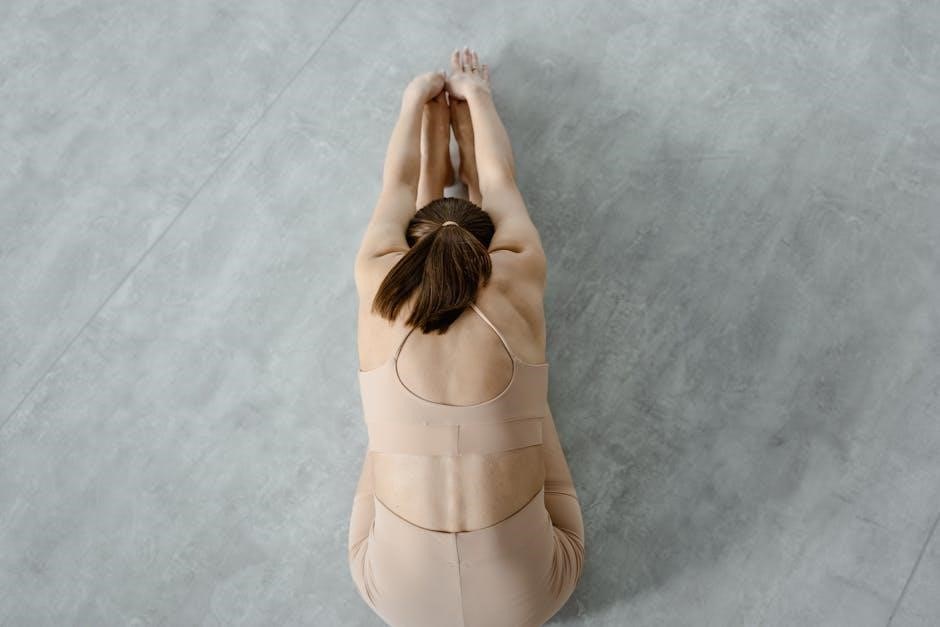Welcome to the world of yoga! This guide offers a gentle introduction to yoga for beginners, featuring essential poses and sequences to help you get started. Discover how yoga can improve flexibility, strength, and mental clarity with our free printable PDF guides, perfect for home practice. Whether you’re new to yoga or looking to deepen your practice, these resources provide a clear and structured approach to help you succeed.
Why Yoga is Perfect for Beginners
Yoga is an excellent choice for beginners because it offers a low-impact, adaptable practice that improves flexibility, strength, and mental clarity. Its slow-paced nature allows for proper alignment and breathing techniques, making it accessible to all body types and fitness levels. Yoga also reduces stress and promotes relaxation, creating a holistic wellness experience. With printable guides and sequences, beginners can easily follow along, ensuring a safe and enjoyable introduction to the practice.
Benefits of a Structured Yoga Sequence
A structured yoga sequence provides clarity and consistency, helping beginners build a strong foundation. It ensures proper alignment, breathing, and progression, reducing the risk of injury. A well-planned sequence also enhances focus and mindfulness, allowing practitioners to experience the full benefits of each pose. By following a structured sequence, beginners can improve flexibility, strength, and balance while gradually advancing their practice in a safe and organized manner.
Essential Yoga Poses for Beginners
Mastering foundational yoga poses is key for beginners. These poses improve flexibility, strength, and balance while promoting mental clarity. They form the basis of a safe and effective practice, with printable guides available to support your journey.
Mountain Pose (Tadasana) ‒ The Foundation
Mountain Pose (Tadasana) is the foundational standing pose in yoga, often considered the starting point for many sequences. It promotes good posture, balance, and awareness. Stand tall with feet hip-width apart, arms by your sides, and engage your core. This pose is essential for establishing a strong, steady base and is often used as a resting pose between more dynamic movements. It’s a simple yet powerful way to connect with your breath and body alignment.
Downward Dog (Adho Mukha Svanasana) ─ Full-Body Stretch
Downward Dog (Adho Mukha Svanasana) is a foundational pose offering a full-body stretch. Start on all fours, then lift your hips to form an inverted V. Keep palms and heels grounded, arms and legs straight, and engage your core. This pose stretches the hamstrings, calves, and spine while strengthening the arms and shoulders. It’s a key component of Sun Salutations and a great way to improve flexibility and balance in your yoga practice.
Child’s Pose (Balasana) ‒ Relaxation and Stretching
Child’s Pose (Balasana) is a resting posture that promotes relaxation and gentle stretching. Kneel on the mat, sit back onto your heels, and stretch your arms forward, lowering your forehead to the ground. This pose stretches the back muscles, hips, and legs while providing a calming effect. It’s often used as a counter-pose to more intense stretches and is ideal for beginners. Hold for 5-10 breaths, modifying knee width for comfort if needed.
Cat-Cow Pose (Marjaryasana-Bitilasana) ─ Spinal Flexibility
Cat-Cow Pose is a gentle, flowing sequence that warms up the spine and improves flexibility. Start on your hands and knees (Table Top Pose). Inhale as you arch your back, lifting your head and tailbone (Cow Pose). Exhale as you round your spine, tucking your chin and pelvis (Cat Pose). Repeat several times, synchronizing breath with movement. This pose relieves tension, promotes spinal mobility, and is an excellent warm-up for beginners. Practice slowly and smoothly for best results.
Warrior I (Virabhadrasana I) ─ Strength and Balance
Warrior I is a foundational standing pose that builds strength and balance. Stand with your feet wide apart, one foot facing forward and the other slightly angled. Bend your front knee deeply, keeping your back leg straight. Extend your arms overhead, gaze forward, and engage your core. Hold for 5-10 breaths, then switch sides. This pose strengthens the legs, hips, and core while improving focus and confidence. Use a block for support if needed.
Seated Forward Fold (Paschimottanasana) ─ Hamstring Stretch
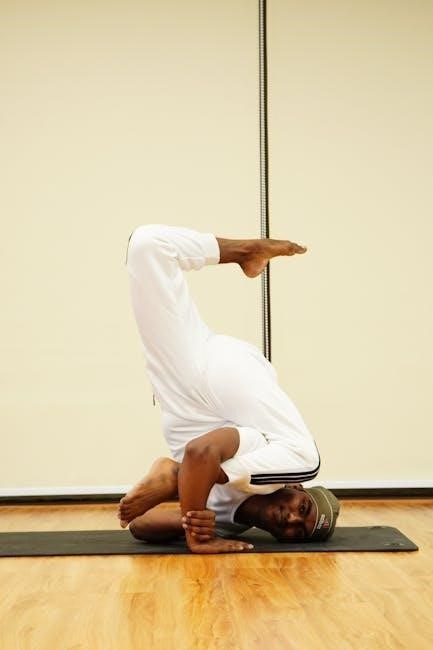
Seated Forward Fold is a calming pose that stretches the hamstrings, calves, and spine. Sit with extended legs, feet flexed, and hands on the ground. Inhale, lengthen your spine, then exhale, folding forward from the hips. Reach for your toes or shins, keeping the knees slightly bent if necessary. Hold for 5-10 breaths, feeling the stretch in the back of your legs and lower back. Modify with a strap if needed for comfort.
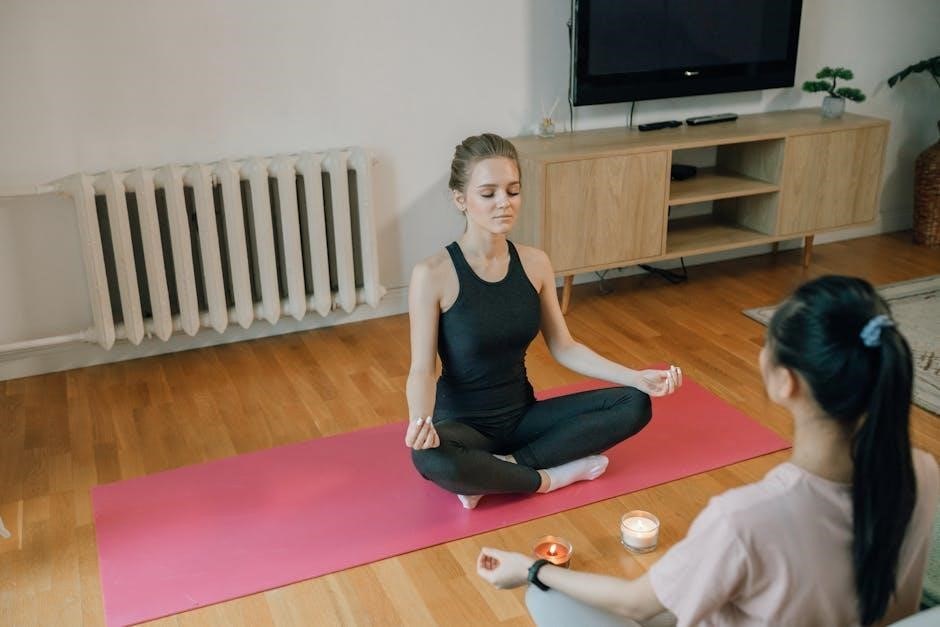
How to Structure a 20-30 Minute Practice
Begin with a 5-minute warm-up, including gentle stretches and breathwork. Dedicate 15-20 minutes to the main sequence, focusing on foundational poses. Conclude with a 5-minute cool down, finishing with Savasana for relaxation and rejuvenation. Adjust timing based on individual needs to ensure a balanced and refreshing practice.
Warm-Up and Preparation
Begin your practice with gentle movements to awaken your body. Start with Cat-Cow Pose to warm up the spine, followed by neck rolls and shoulder stretches. Include Child’s Pose to center your breath and prepare your muscles. Use a wall for support in standing poses if needed. Take a few moments to set an intention for your practice, ensuring a calm and focused mindset. This preparation sets the foundation for a safe and effective yoga sequence.
Main Yoga Sequence
Begin with foundational poses like Mountain Pose and Downward Dog for alignment and a full-body stretch; Transition into Warrior I and II to build strength and balance. Include Seated Forward Fold for hamstring flexibility and Cat-Cow Pose for spinal mobility. Hold each pose for 3-5 breaths, focusing on proper alignment and breathing. This structured sequence gradually increases intensity, ensuring a balanced and effective practice for beginners. It combines strength, flexibility, and relaxation to enhance overall well-being.
Cool Down and Final Relaxation
End your practice with calming poses like Child’s Pose and Savasana to promote relaxation and reduce stress. Gentle stretches and deep breathing help cool down the body and mind. Hold each pose for 5-10 breaths, focusing on releasing tension. This final phase allows your body to unwind, rejuvenating your energy and leaving you feeling refreshed and centered. It’s essential to conclude with mindfulness, ensuring a peaceful end to your yoga session.
Creating a Printable Yoga Sequence PDF
Create a clear, user-friendly guide featuring images and step-by-step instructions. Include essential poses, breathing techniques, and modifications. Ensure it’s visually appealing and easy to follow for home practice.
Design Tips for a Clear and User-Friendly Guide
Use high-quality images and clear instructions for each pose. Include Sanskrit names and modifications for accessibility. Ensure a clean layout with ample spacing and readable fonts. Organize poses logically, grouping by type or flow. Add visual aids like arrows or alignment cues. Use color coding or icons to highlight key points. Include breathing tips and duration for each pose. Make sure the PDF is mobile-friendly and easy to print. Keep the design simple and focused for an optimal user experience.
Visual Aids for Better Understanding
Include high-quality images or diagrams for each pose to illustrate proper alignment and form. Use arrows or cues to show breathing techniques or transitions. Add videos or GIFs for dynamic poses. Incorporate anatomical illustrations to highlight targeted muscle groups. Use color-coded sequences to visually guide the flow of the practice. Ensure images are clear and large enough to see details, making it easier for beginners to follow along confidently and safely.
Safety and Modifications for Beginners
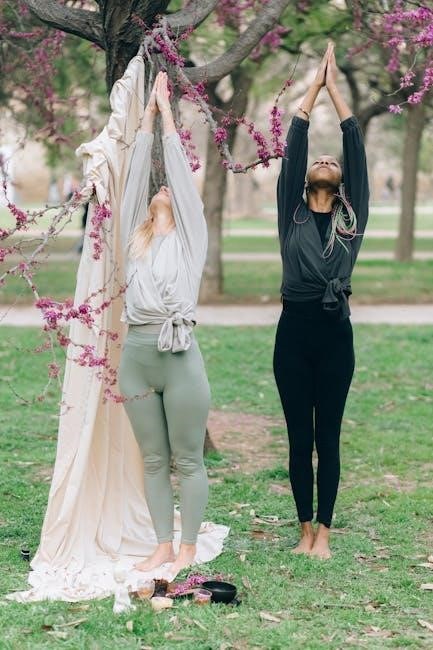
Always modify poses to suit your body, use props for support, and avoid pushing past pain. Consult a professional to ensure safe practice and prevent injuries.
Modifications for Each Pose
Modify poses to suit your body using props like blocks or blankets. For standing poses, use a wall for support. During menstruation, avoid deep twists and inversions. Hold poses for 5-10 breaths, adjusting as needed. If a pose feels uncomfortable, rest or try a simpler variation. Always prioritize comfort and safety to prevent injuries and enhance your practice experience.
How to Avoid Common Injuries
To prevent injuries, warm up thoroughly before practice and listen to your body. Avoid pushing past pain or discomfort. Use proper alignment and breathing techniques. Modify poses if needed, especially during menstruation. Practice on a non-slip surface and consider using props for support. Rest when needed and avoid overexertion. Prioritize safety and mindful movement to enjoy a injury-free yoga journey.
Benefits of Following a Yoga Sequence
Following a yoga sequence enhances physical and mental well-being by improving flexibility, strength, and balance. It also promotes calmness, focus, and posture, fostering overall health and mindfulness.
Physical Benefits
Following a yoga sequence for beginners enhances physical health by improving flexibility, balance, and strength. Regular practice strengthens core muscles, boosts circulation, and increases range of motion. Standing poses like Mountain Pose and Warrior I improve posture and stability, while stretches like Seated Forward Fold and Downward Dog relieve tension and lengthen muscles. Consistent practice promotes better alignment, reduces muscle soreness, and enhances overall physical well-being, making it ideal for building a strong, healthy body.
Mental and Emotional Benefits
Yoga sequences for beginners offer profound mental and emotional benefits. By focusing on breath and movement, practices like Child’s Pose and Cat-Cow Pose reduce stress and anxiety. These exercises promote mindfulness, helping you stay present and centered. Over time, yoga enhances emotional resilience, improves mood, and fosters a sense of calm and inner peace. Regular practice can also boost self-confidence and overall well-being, making it a holistic approach to mental health.
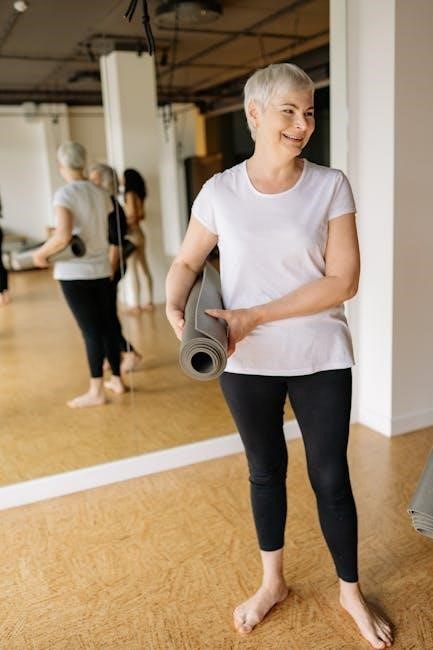
Free Yoga Sequence PDF Resources
Discover free yoga sequence PDFs designed for beginners, offering step-by-step guides and visuals. Websites like Yoga With Uliana provide downloadable resources to enhance your home practice journey.
Where to Find Printable Guides
Find free yoga sequence PDFs on websites like Yoga With Uliana, offering 25 must-know poses for beginners. Download guides from platforms like Etsy and Darebee, featuring step-by-step instructions and images. These resources are perfect for home practice and can be used alongside YouTube lessons. Printable charts and posture guides are also available, ensuring a clear and structured approach to your yoga journey. Explore these websites for comprehensive and user-friendly materials tailored for beginners.
Recommended Websites for Beginners
Visit Yoga With Uliana for free downloadable PDFs featuring 25 essential poses. Darebee offers comprehensive guides with step-by-step instructions and images. Etsy provides yoga pose charts and illustrations for home practice. These websites are ideal for beginners, offering clear, structured resources to help you build a strong foundation in yoga. Explore these platforms to find the perfect guides for your journey, ensuring a smooth and enjoyable learning experience.
Embrace yoga as a journey of self-discovery and growth. Stay consistent, celebrate small victories, and enjoy the transformative benefits of yoga for body, mind, and soul.
Final Thoughts and Encouragement
Yoga is a journey, not a destination. Celebrate small victories, honor your body, and stay consistent. With patience and practice, you’ll unlock the physical, mental, and emotional benefits of yoga. Use the printable guides to create a routine that suits your needs and lifestyle. Remember, every pose is a step toward wellness. Embrace the process, stay kind to yourself, and enjoy the transformative power of yoga. Happy practicing!
